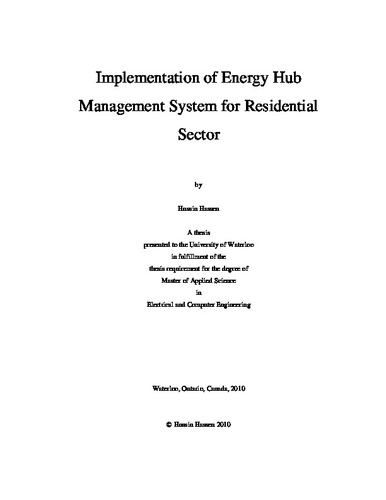| dc.contributor.author | Hassen, Hussin | |
| dc.date.accessioned | 2010-05-21 15:13:29 (GMT) | |
| dc.date.available | 2010-05-21 15:13:29 (GMT) | |
| dc.date.issued | 2010-05-21T15:13:29Z | |
| dc.date.submitted | 2010 | |
| dc.identifier.uri | http://hdl.handle.net/10012/5224 | |
| dc.description.abstract | This thesis is concerned with the implementation of a proposed Energy Hub Management System (EHMS) mathematical model for residential appliances under Time of Use (TOU) based electricity rate structure. The objective is to shift the residential electrical energy consumption during periods of high grid energy demand to low demand periods subject to operational constraints. The customer benefits from reduced daily energy consumption and consequent reduction to its cost with minimal effect on the comfort level.
Two scheduling periods are considered simultaneously. The first is a 24-interval schedule with one-hour time steps for appliances such as a dishwasher, clothes washer and dryer. The second is a 96-interval schedule with 15-minute time steps for other appliances such as refrigerator, freezer and water heater. Each appliance has been modeled as a discrete time linear dynamic system and the objective of this thesis is to make these models work in a real world situation by determining realistic estimations of the model parameters and constants. It is vital to properly calculate the mathematical model parameters as they have direct impact on the results. Minor modifications to some domestic appliance models were proposed to make the practical implementation easier. It was found that while some parameters in the mathematical model can be easily calculated based on thermodynamic equations, other parameters are hard to be calculated; therefore, a practical procedure was proposed to measure these parameters. An experiment on a small refrigerator was carried out to validate the refrigerator mathematical model and parameters measurement procedure.
The resulting model is a mixed integer linear problem (MILP) and was solved using GNU Linear Programming Kit (GLPK) freeware solver. The performance of GLPK was found to be satisfactory as compared to the commercial solver CPLEX, and was particularly suitable for practical and commercial implementations. | en |
| dc.language.iso | en | en |
| dc.publisher | University of Waterloo | en |
| dc.subject | Implementation | en |
| dc.subject | EHMS | en |
| dc.subject | MILP | en |
| dc.subject | GLPK | en |
| dc.subject | DSM | en |
| dc.subject | scheduling | en |
| dc.title | Implementation of Energy Hub Management System for Residential Sector | en |
| dc.type | Master Thesis | en |
| dc.pending | false | en |
| dc.subject.program | Electrical and Computer Engineering | en |
| uws-etd.degree.department | Electrical and Computer Engineering | en |
| uws-etd.degree | Master of Applied Science | en |
| uws.typeOfResource | Text | en |
| uws.peerReviewStatus | Unreviewed | en |
| uws.scholarLevel | Graduate | en |

